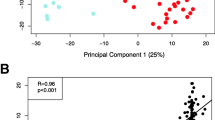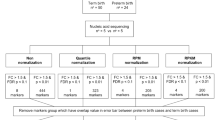Abstract
Turner syndrome is a sex chromosome aneuploidy with characteristic malformations. Amniotic fluid, a complex biological material, could contribute to the understanding of Turner syndrome pathogenesis. In this pilot study, global gene expression analysis of cell-free RNA in amniotic fluid supernatant was utilized to identify specific genes/organ systems that may play a role in Turner syndrome pathophysiology. Cell-free RNA from amniotic fluid of five mid-trimester Turner syndrome fetuses and five euploid female fetuses matched for gestational age was extracted, amplified, and hybridized onto Affymetrix® U133 Plus 2.0 arrays. Significantly differentially regulated genes were identified using paired t tests. Biological interpretation was performed using Ingenuity Pathway Analysis and BioGPS gene expression atlas. There were 470 statistically significantly differentially expressed genes identified. They were widely distributed across the genome. XIST was significantly down-regulated (p < 0.0001); SHOX was not differentially expressed. One of the most highly represented organ systems was the hematologic/immune system, distinguishing the Turner syndrome transcriptome from other aneuploidies we previously studied. Manual curation of the differentially expressed gene list identified genes of possible pathologic significance, including NFATC3, IGFBP5, and LDLR. Transcriptomic differences in the amniotic fluid of Turner syndrome fetuses are due to genome-wide dysregulation. The hematologic/immune system differences may play a role in early-onset autoimmune dysfunction. Other genes identified with possible pathologic significance are associated with cardiac and skeletal systems, which are known to be affected in females with Turner syndrome. The discovery-driven approach described here may be useful in elucidating novel mechanisms of disease in Turner syndrome.
Similar content being viewed by others
References
Bakalov VK, Gutin L, Cheng CM, Zhou J, Sheth P, Shah K, Arepalli S, Vanderhoof V, Nelson LM, Bondy CA (2012) Autoimmune disorders in women with Turner syndrome and women with karyotypically normal primary ovarian insufficiency. J Autoimmun 38:315–321
Bianchi D, Crombleholme T, D’Alton M, Malone F (2010) 45,X (Turner syndrome). In: Fetology: Diagnosis and management of the fetal patient, 2nd edn. McGraw-Hill Companies, New York
Bierer R, Nitta CH, Friedman J, Codianni S, de Frutos S, Dominguez-Bautista JA, Howard TA, Resta TC, Gonzalez Bosc LV (2011) NFATc3 is required for chronic hypoxia-induced pulmonary hypertension in adult and neonatal mice. Am J Physiol Lung Cell Mol Physiol 301:L872–L880
Bondy CA (2007) Turner syndrome study group: care of girls and women with Turner syndrome: a guideline of the Turner syndrome study group. J Clin Endocrinol Metab 92:10–25
Clarkson PM, Nicholson MR, Barratt-Boyes BG, Neutze JM, Whitlock RM (1983) Results after repair of coarctation of the aorta beyond infancy: a 10–28 years follow-up with particular reference to late systemic hypertension. Am J Cardiol 51:1481–1488
de Frutos S, Caldwell E, Nitta CH, Kanagy NL, Wang J, Wang W, Walker MK, Gonzalez Bosc LV (2010) NFATc3 contributes to intermittent hypoxia-induced arterial remodeling in mice. Am J Physiol Heart Circ Physiol 299:H356–H363
Devlin RD, Du Z, Buccilli V, Jorgetti V, Canalis E (2002) Transgenic mice overexpressing insulin-like growth factor binding protein-5 display transiently decreased osteoblastic function and osteopenia. Endocrinology 143:3955–3962
Dietz JA, Johnson KL, Massingham LJ, Schaper J, Horlitz M, Cowan J, Bianchi DW (2011) Comparison of extraction techniques for amniotic fluid supernatant demonstrates improved yield of cell-free fetal RNA. Prenat Diagn 31:598–599
Elsheikh M, Dunger DB, Conway GS, Wass JA (2002) Turner’s syndrome in adulthood. Endocr Rev 23:120–140
FitzSimmons J, Fantel A, Shepard TH (1994) Growth parameters in mid-trimester fetal Turner syndrome. Early Hum Dev 38:121–129
Giordano R, Forno D, Lanfranco F, Manieri C, Ghizzoni L, Ghigo E (2011) Metabolic and cardiovascular outcomes in a group of adult patients with Turner’s syndrome under hormonal replacement therapy. Eur J Endocrinol 164:819–826
Gobert M, Lafaille JJ (2012) Maternal–fetal immune tolerance, block by block. Cell 150:7–9
Gravholt CH (2004) Epidemiological, endocrine, and metabolic features in Turner syndrome. Eur J Endocrinol 151:657–687
Gravholt CH, Juul S, Naeraa RW, Hansen J (1998) Morbidity in Turner syndrome. J Clin Epidemiol 51:147–158
Hall JG, Sybert VP, Williamson RA, Risher NL, Reed SD (1982) Turner’s syndrome. West J Med 137:32–44
Hintz RL (2002) SHOX mutations. Rev Endocr Metab Disord 3:363–367
Horsley V, Pavlath GK (2002) NFAT: ubiquitous regulator of cell differentiation and adaptation. J Cell Biol 156:771–774
Hui L, Slonim DK, Wick HC, Johnson KL, Bianchi DW (2012a) The amniotic fluid transcriptome: a source of novel information about human fetal development. Obstet Gynecol 119:111–118
Hui L, Slonin DK, Wick HC, Johnson KL, Koide K, Bianchi DW (2012b) Novel neurodevelopmental information revealed in amniotic fluid supernatant transcripts from fetuses with trisomies 18 and 21. Hum Genet 131:1751–1759
Jørgensen KT, Rostgaard K, Bache I, Biggar RJ, Nielsen NM, Tommerup N, Frisch M (2010) Autoimmune diseases in women with Turner’s syndrome. Arthr Rheum 62:658–666
Kanatani M, Sugimoto T, Nishiyama K, Chihara K (2000) Stimulatory effect of insulin-like growth factor binding protein-5 on mouse osteoclast formation and osteoclastic bone-resorbing activity. J Bone Miner Res 15:902–910
Kenny D, Polson JW, Martin RP, Paton JF, Wolf AR (2011) Hypertension and coarctation of the aorta: an inevitable consequence of developmental pathophysiology. Hypertens Res 34:543–547
Kim KS, Seu YB, Baek SH, Kim MJ, Kim KJ, Kim JH, Kim JR (2007) Induction of cellular senescence by insulin-like growth factor binding protein-5 through a p53-dependent mechanism. Mol Biol Cell 18:4543–4552
Koide K, Slonim DK, Johnson KL, Tantravahi U, Cowan JM, Bianchi DW (2011) Transcriptomic analysis of cell-free fetal RNA suggests a specific molecular phenotype in trisomy 18. Hum Genet 129:295–305
Kojima H, Kunimoto H, Inoue T, Nakajima K (2012) The STAT3–IGFBP5 axis is critical for IL-6/gp130-induced premature senescence in human fibroblasts. Cell Cycle 11:730–739
Larrabee PB, Johnson KL, Lai C, Ordovas J, Cowan JM, Tantravahi U, Bianchi DW (2005) Global gene expression analysis of the living human fetus using cell-free messenger RNA in amniotic fluid. JAMA 293:836–842
Nielsen J, Wohlert M (1991) Chromosome abnormalities found among 34,910 newborn children: results from a 13-year incidence study in Arhus, Denmark. Hum Genet 87:81–83
Papp C, Beke A, Mezi G, Szigeti Z, Ban Z, Papp Z (2006) Prenatal diagnosis of Turner syndrome; report on 69 cases. J Ultrasound Med 25:711–717
Pavlidis P, Li Q, Noble WS (2003) The effect of replication on gene expression microarray experiments. Bioinformatics 19(13):1620–1627
Ross JL, Feuillan P, Long LM, Kowal K, Kushner H, Cutler GB Jr (1995) Lipid abnormalities in Turner syndrome. J Pediatr 126:242–245
Salih DA, Tripathi G, Holding C, Szestak TA, Gonzalez MI, Carter EJ, Cobb LJ, Eisemann JE, Pell JM (2004) Insulin-like growth factor-binding protein 5 (Igfbp5) compromises survival, growth, muscle development, and fertility in mice. Proc Natl Acad Sci USA 101:4314–4319
Slonim DK, Koide K, Johnson KL, Tantravahi U, Cowan JM, Jarrah Z, Bianchi DW (2009) Functional genomic analysis of amniotic fluid cell-free mRNA suggests that oxidative stress is significant in Down syndrome fetuses. Proc Natl Acad Sci USA 106:9425–9429
Su AI, Wiltshire T, Batalov S, Lapp H, Ching KA, Block D, Zhang J, Soden R, Hayakawa M, Kreiman G, Cooke MP, Walker JR, Hogenesch JB (2004) A gene atlas of the mouse and human protein-encoding transcriptomes. Proc Natl Acad Sci USA 101:6062–6067
Tyler C, Edman JC (2004) Down syndrome, Turner syndrome, and Klinefelter syndrome: primary care throughout the life span. Prim Care 31:627–648
Van PL, Bakalov VD, Bondy CA (2006) Monosomy for the X-chromosome is associated with an atherogenic lipid profile. J Clin Endocrinol Metab 91:2867–2870
Wu C, Orozco C, Boyer J, Leglise M, Goodale J, Batalov S, Hodge CL, Haase J, Janes J, Huss JW 3rd, Su AI (2009) BioGPS: an extensible and customizable portal for querying and organizing gene annotation resources. Genome Biol 10:R130
Acknowledgments
Funding for this study was provided by the Eunice Kennedy Shriver National Institute of Child Health and Human Development [R01 HD42053-10 to DWB and R01 HD058880-04 to DKS].
Conflict of interest
The authors declare no conflict of interest.
Author information
Authors and Affiliations
Corresponding author
Electronic supplementary material
Below is the link to the electronic supplementary material.
Rights and permissions
About this article
Cite this article
Massingham, L.J., Johnson, K.L., Scholl, T.M. et al. Amniotic fluid RNA gene expression profiling provides insights into the phenotype of Turner syndrome. Hum Genet 133, 1075–1082 (2014). https://doi.org/10.1007/s00439-014-1448-y
Received:
Accepted:
Published:
Issue Date:
DOI: https://doi.org/10.1007/s00439-014-1448-y




